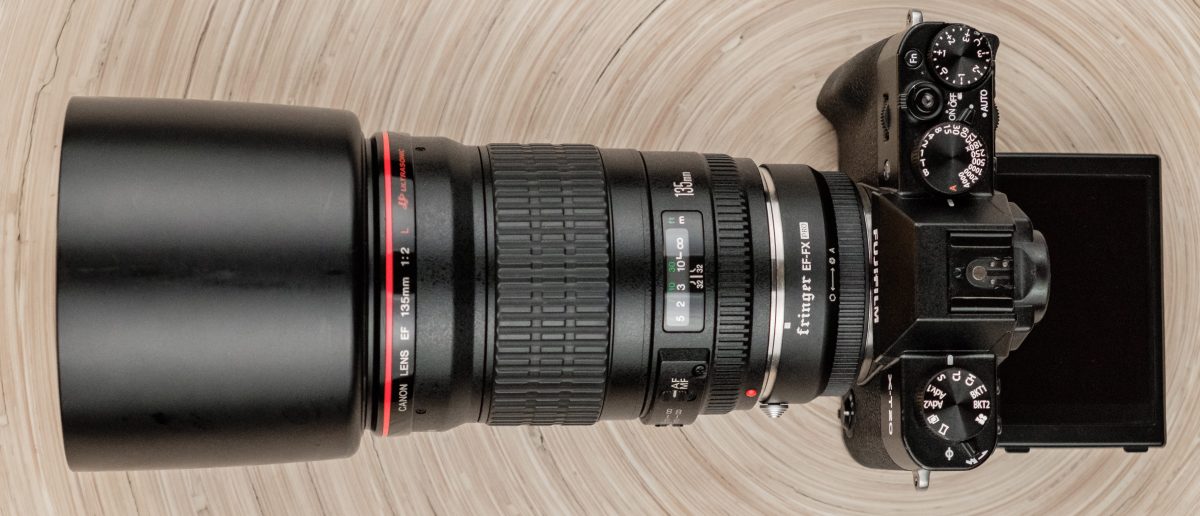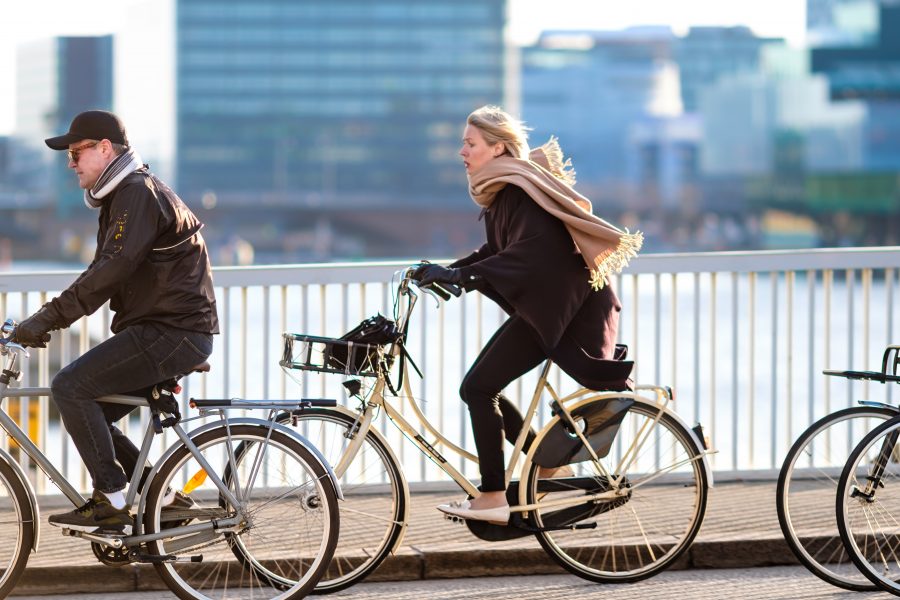This is a short review of the Fringer Canon EF to Fujifilm X lens adapter, a so called smart adapter meaning it let’s you use auto focus with Canon lenses on your Fujifilm X camera. Smart adapter’s for Canon lenses have been available some time now for Sony cameras but this is the first for the Fujifilm X systems.
I take a lot of photos of bicycles in Copenhagen. They move fast so it requires good auto focus ability and long fast lenses. Fujifilm lacks those longer prime lenses, the longest is the 90mm f2 but it’s too short. I bought this adapter to try out lenses like the 135mm f2, 200mm f2 or 300mm f2.8.
I bought the Canon EF 135mm f2 USM and I also borrowed a few other lenses to test it with: Canon XF 85mm f1.2 L II, Canon EF 50mm f1.8 II and Canon EF-S 18-55mm f3.5-5.6 STM.
Product overview
- Can mount Canon EF lenses on your Fujifilm X camera. A long list of lenses have been tested.
- Auto focuses lenses.
- Image Stabilization also works if lenses have that option.
- Aperture ring to change aperture. Turning it all the way to the side sets it into auto.
- Lens EXIF data gets saved, focal length and aperture.
- Price is $299 bought from Fringer website.
Testing the auto focus
After testing it for a few weeks I can say that the adapter works, auto focusing works, the question is how good does it work? Will it work on fast moving subjects?
I tried to test auto focus of moving subject coming towards me with these 3 setups:
- Fujifilm X-T20 + Fujifilm XF 55-200mm f3.5-4.8 at 135mm.
- Fujifilm X-T20 + Fringer adapter + Canon EF 135mm f2.
- Canon 80D + Canon EF 135mm f2
Results was a bit mixed. Shooting in single focus mode things works pretty good and auto focus is only a bit slower than Fujifilm native lenses. For continuous auto focus the results was not good enough. Focus was close but not 100%. My advice would be to only buy this adapter if you don’t do a lot of fast moving shooting (which most people don’t).
Fujifilm X-T20 + Fringer adapter vs. Canon 80D
I bought a Canon 80D camera to compare with the Fujifilm X-T20 + Fringer adapter. If you already know Canon cameras, this won’t have interest for you. But for people like me that only uses Fujifilm, here are some interesting observations:
- The Canon 80D focuses a bit faster than the Fringer adapter but that’s to be expected.
- DSLR’s are just better for real professional work, the viewfinder is clear and easy to track fast moving subjects with. Noting compares to DSLR’s when tracking fast moving subjects.
- On the other hand DSLR’s are big and clunky. I rarely take photos with it walking around alone on the streets. So unless your photography is professionally paid work, you will probably prefer a smaller mirrorless camera with a flipscreen.
- The Canon Colors: I know a lof of gear relativists are gonna disagree (“all gear are basically the same, it’s about your skills”) but there is something about the colors in some camera. I dislike the Nikon colors, the Fujifilm colors are great and so are the Canon colors. The Canon colors are beautiful, especially for those golden our people photos, it’s the color style you have seen everywhere for the last 10 years. Fujifilm has a bit more of an analog film look, a bit more hipster friendly colors. I like both.
- Photos from the Canon lenses look better from a Canon camera than a Fujifilm camera. It’s like they miss some colors and contrast compared to when they where taken with a Canon camera or if using native Fujifilm lenses. Colors of photos with the Finger looks very blue (compared to native Canon or Fujifilm results), but not something easy to fix in post.

Taken with the Canon 80D + Canon EF 135mm f2 – to me this is clearly Canon colors, a bit warmer, I like it! Full size version here (Flickr)
Conclusion
I would recommend people to stick to native Fujifilm lenses.
Pros:
- Basic auto focus works.
- Exif data gets stored in your images.
- Keeps getting better through firmware updates.
Cons:
- Auto focus works but only in single focus. In continuous focus it dosen’t focus 100%.
- The colors and rendition is not like native Fujifilm lenses, and not something easy to fix in post production.
2023 Update
I sold the adapter short time after writing this blog post, but in 2023 I have been shooting more analog film with my old Canon EOS film cameras, and I was tired of carrying lenses for both my Canon EOS film cameras and my digital Fujifilm X cameras, so I bought a Fringer adapter again, this time I got the Fringer EF-FX II Adapter, a newer updated version. I was excited to see if Fringer had managed to make the images look better (maybe apply some kind of lens profile?).
Auto focus was better, they claim that phase detection now works, and I guess you could use it for moving subjects now. But the image quality problems was still the same. This time I have gathered even more EF lenses, and all of them gave me those very bleak images, a strong blue color cast that was hard to remove, and very contrasty images. Highlights are often blown out, and shadows are also often crushed. Not sure what’s going on. On my Canon cameras I don’t notice the same problem at all, my theory is that those Canon EF lenses maybe are not that great but Canon apply some kind of correction profile to the images (making them less blue, lowering contrast, plus something else I can not emulate). Also those Canon EF lenses don’t seem that sharp on Fujifilm X.
I would stay away unless Canon EF is your main camera and Fujifilm X is a 2nd or 3rd camera system for you, and you just want to be able to use some of the lenses you already have on your Fuji.
Links
- Fringer’s official product page – where you can also order the adapter. If it’s not in stock try to write them.




Dear kristoffer,
I wanna to buy a fringer adapter for my xt3 + canon 135mm 2.0, but I would like to see more you photos. Can you to show me more? Do you have?
Thank you!
Joventino Neto
@joventinoneto
Hej Krisstoffer,
Jeg overvejede en adapter til min xt3 da jeg både har canon 5d4 og fuji udstyr.
Begge kameraer gør det godt, og begge laver flotte naturlige farver, canon synes jeg er en lille smule foran, men betaler sin pris i størrelsen.
Efter at have læst hvad du har skrevet undlader jeg at købe en adapter.
Tak